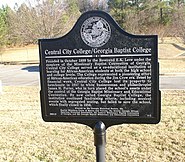Georgia Baptist College
The idea for the school originated in the 1890s due to internal conflicts among African American Baptists in the U.S. state of Georgia.
[4] Tensions were further inflamed in 1894 when Malcolm MacVicar, the white superintendent of education for the ABHMS, gave a speech where he said it would take a century before African Americans could be capable of managing their own churches and schools.
[5] In 1897, seeking to defuse the tension, the ABHMS agreed to work with African Americans to ensure increased representation on the colleges' boards of trustees.
[6][7] That same year, Atlanta Baptist was re-incorporated as a college, though African Americans were still largely excluded from leadership positions,[4] a trend that would continue through 1899.
[12][8][10] In September 1899, a representative of the school reached out to William E. Holmes, an African American faculty member from Atlanta Baptist, to offer him the position of president for this new college.
[27] By the following year, the school officially began its college department,[28][29] and the number of teachers had risen to eight.
[30] In the aftermath of the destruction, community farmers sold some of their produce to raise money for the school's reconstruction, collecting about $164.34 for the school, while the Reverend T. J. Goodall (preacher at First African Baptist Church in Savannah and a board member of Central City College) personally donated $50 to the cause.
[30] For the fall semester that year, the school enrolled 204 students, with classes being held in tents set up on the campus.
[29] Shortly before Christmas 1921, Holmes was visited at Central City College by Hope (who by this time was president of Atlanta Baptist, which had since been renamed to Morehouse College), E. C. Sage of the General Education Board (GEB, a private organization that supported schools for African Americans) and the Reverend M. W. Reddick (president of the Missionary Baptist Convention), who came to discuss the possible future of the school.
[34] During a trip to New York City, he was able to secure donations from the National Baptist Convention, and he committed his entire year's salary of $1,800 to the fundraising efforts.
[34] Additional contributions came from members of the Macon community and statewide Baptist groups, and James H. Porter, a local industrialist and philanthropist who was the head of Central City's white advisory board, donated $5,000.
[9] The school continued to operate and promote fundraising efforts, including staging musical events before racially segregated audiences.
[6] Range, in a 1951 book about historically black colleges and universities in Georgia, reflected on the school by saying it was created "in the spirit of antagonism" which left it "without universal sanction or support", which caused it "to fight for its existence" while "its work at higher learning remained a petty and pitiful affair".


